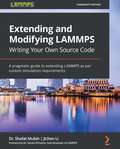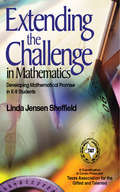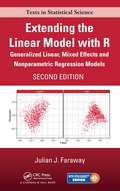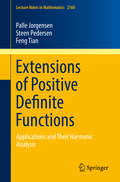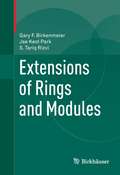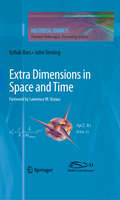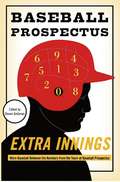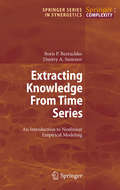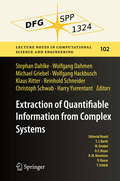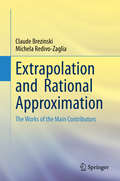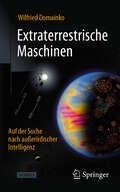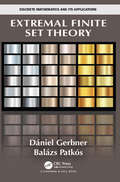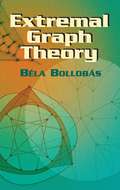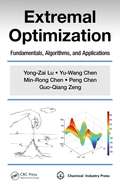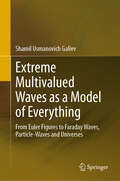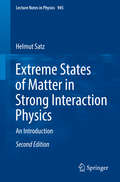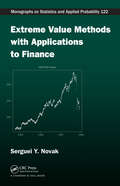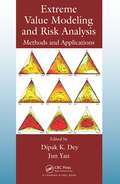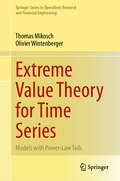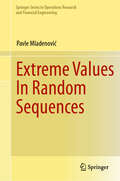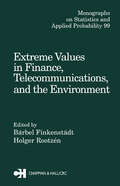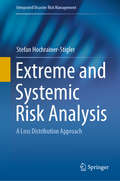- Table View
- List View
Extending and Modifying LAMMPS Writing Your Own Source Code: A pragmatic guide to extending LAMMPS as per custom simulation requirements
by Dr. Shafat Mubin Jichen Li Dr. Steven PlimptonUnderstand the LAMMPS source code and modify it to meet your research needs, and run simulations for bespoke applications involving forces, thermostats, pair potentials and more with easeKey FeaturesUnderstand the structure of the LAMMPS source codeImplement custom features in the LAMMPS source code to meet your research needsRun example simulations involving forces, thermostats, and pair potentials based on implemented featuresBook DescriptionLAMMPS is one of the most widely used tools for running simulations for research in molecular dynamics. While the tool itself is fairly easy to use, more often than not you'll need to customize it to meet your specific simulation requirements. Extending and Modifying LAMMPS bridges this learning gap and helps you achieve this by writing custom code to add new features to LAMMPS source code. Written by ardent supporters of LAMMPS, this practical guide will enable you to extend the capabilities of LAMMPS with the help of step-by-step explanations of essential concepts, practical examples, and self-assessment questions. This LAMMPS book provides a hands-on approach to implementing associated methodologies that will get you up and running and productive in no time. You'll begin with a short introduction to the internal mechanisms of LAMMPS, and gradually transition to an overview of the source code along with a tutorial on modifying it. As you advance, you'll understand the structure, syntax, and organization of LAMMPS source code, and be able to write your own source code extensions to LAMMPS that implement features beyond the ones available in standard downloadable versions. By the end of this book, you'll have learned how to add your own extensions and modifications to the LAMMPS source code that can implement features that suit your simulation requirements.What you will learnIdentify how LAMMPS input script commands are parsed within the source codeUnderstand the architecture of the source codeRelate source code elements to simulated quantitiesLearn how stored quantities are accessed within the source codeExplore the mechanisms controlling pair styles, computes, and fixesModify the source code to implement custom features in LAMMPSWho this book is forThis book is for students, faculty members, and researchers who are currently using LAMMPS or considering switching to LAMMPS, have a basic knowledge of how to use LAMMPS, and are looking to extend LAMMPS source code for research purposes. This book is not a tutorial on using LAMMPS or writing LAMMPS scripts, and it is assumed that the reader is comfortable with the basic LAMMPS syntax. The book is geared toward users with little to no experience in source code editing. Familiarity with C++ programming is helpful but not necessary.
Extending the Challenge in Mathematics: Developing Mathematical Promise in K-8 Students
by Linda Jensen SheffieldThis guide provides the practical tips and tools educators need to help their mathematically promising students develop their potential to the fullest.
Extending the Linear Model with R: Generalized Linear, Mixed Effects and Nonparametric Regression Models, Second Edition (Chapman & Hall/CRC Texts in Statistical Science)
by Julian J. FarawayStart Analyzing a Wide Range of Problems Since the publication of the bestselling, highly recommended first edition, R has considerably expanded both in popularity and in the number of packages available. Extending the Linear Model with R: Generalized Linear, Mixed Effects and Nonparametric Regression Models, Second Edition takes advantage of the greater functionality now available in R and substantially revises and adds several topics.New to the Second Edition Expanded coverage of binary and binomial responses, including proportion responses, quasibinomial and beta regression, and applied considerations regarding these models New sections on Poisson models with dispersion, zero inflated count models, linear discriminant analysis, and sandwich and robust estimation for generalized linear models (GLMs) Revised chapters on random effects and repeated measures that reflect changes in the lme4 package and show how to perform hypothesis testing for the models using other methods New chapter on the Bayesian analysis of mixed effect models that illustrates the use of STAN and presents the approximation method of INLA Revised chapter on generalized linear mixed models to reflect the much richer choice of fitting software now available Updated coverage of splines and confidence bands in the chapter on nonparametric regression New material on random forests for regression and classification Revamped R code throughout, particularly the many plots using the ggplot2 package Revised and expanded exercises with solutions now included Demonstrates the Interplay of Theory and PracticeThis textbook continues to cover a range of techniques that grow from the linear regression model. It presents three extensions to the linear framework: GLMs, mixed effect models, and nonparametric regression models. The book explains data analysis using real examples and includes all the R commands necessary to reproduce the analyses.
Extensions of Positive Definite Functions
by Palle Jorgensen Steen Pedersen Feng TianThis monograph deals with the mathematics of extending given partial data-sets obtained from experiments; Experimentalists frequently gather spectral data when the observed data is limited, e. g. , by the precision of instruments; or by other limiting external factors. Here the limited information is a restriction, and the extensions take the form of full positive definite function on some prescribed group. It is therefore both an art and a science to produce solid conclusions from restricted or limited data. While the theory of is important in many areas of pure and applied mathematics, it is difficult for students and for the novice to the field, to find accessible presentations which cover all relevant points of view, as well as stressing common ideas and interconnections. We have aimed at filling this gap, and we have stressed hands-on-examples.
Extensions of Rings and Modules
by Jae Keol Park S Tariq Rizvi Gary F. BirkenmeierThe "extensions" of rings and modules have yet to be explored in detail in a research monograph. This book presents state of the art research and also stimulating new and further research. Broken into three parts, Part I begins with basic notions, terminology, definitions and a description of the classes of rings and modules. Part II considers the transference of conditions between a base ring or module and its extensions. And Part III utilizes the concept of a minimal essental extension with respect to a specific class (a hull). Mathematical interdisciplinary applications appear throughout. Major applications of the ring and module theory to Functional Analysis, especially C*-algebras, appear in Part III, make this book of interest to Algebra and Functional Analysis researchers. Notes and exercises at the end of every chapter, and open problems at the end of all three parts, lend this as an ideal textbook for graduate or advanced undergradate students.
Exterior Billiards
by Alexander PlakhovA billiard is a dynamical system in which a point particle alternates between free motion and specular reflections from the boundary of a domain. Exterior Billiards presents billiards in the complement of domains and their applications in aerodynamics and geometrical optics. This book distinguishes itself from existing literature by presenting billiard dynamics outside bounded domains, including scattering, resistance, invisibility and retro-reflection. It begins with an overview of the mathematical notations used throughout the book and a brief review of the main results. Chapters 2 and 3 are focused on problems of minimal resistance and Newton's problem in media with positive temperature. In chapters 4 and 5, scattering of billiards by nonconvex and rough domains is characterized and some related special problems of optimal mass transportation are studied. Applications in aerodynamics are addressed next and problems of invisibility and retro-reflection within the framework of geometric optics conclude the text. The book will appeal to mathematicians working in dynamical systems and calculus of variations. Specialists working in the areas of applications discussed will also find it useful.
Extra Dimensions in Space and Time
by Lawrence Krauss John Terning Farzad Nekoogar Itzhak BarsIn physics, the idea of extra spatial dimensions originates from Nordstöm's 5-dimensional vector theory in 1914, followed by Kaluza-Klein theory in 1921, in an effort to unify general relativity and electromagnetism in a 5 dimensional space-time (4 dimensions for space and 1 for time). Kaluza-Klein theory didn't generate enough interest with physicist for the next five decades, due to its problems with inconsistencies. With the advent of supergravity theory (the theory that unifies general relativity and supersymmetry theories) in late 1970's and eventually, string theories (1980s) and M-theory (1990s), the dimensions of space-time increased to 11 (10-space and 1-time dimension). There are two main features in this book that differentiates it from other books written about extra dimensions: The first feature is the coverage of extra dimensions in time (Two Time physics), which has not been covered in earlier books about extra dimensions. All other books mainly cover extra spatial dimensions. The second feature deals with level of presentation. The material is presented in a non-technical language followed by additional sections (in the form of appendices or footnotes) that explain the basic equations and formulas in the theories. This feature is very attractive to readers who want to find out more about the theories involved beyond the basic description for a layperson. The text is designed for scientifically literate non-specialists who want to know the latest discoveries in theoretical physics in a non-technical language. Readers with basic undergraduate background in modern physics and quantum mechanics can easily understand the technical sections. Part I starts with an overview of the Standard Model of particles and forces, notions of Einstein's special and general relativity, and the overall view of the universe from the Big Bang to the present epoch, and covers Two-Time physics. 2T-physics has worked correctly at all scales of physics, both macroscopic and microscopic, for which there is experimental data so far. In addition to revealing hidden information even in familiar "everyday" physics, it also makes testable predictions in lesser known physics regimes that could be analyzed at the energy scales of the Large Hadron Collider at CERN or in cosmological observations." Part II of the book is focused on extra dimensions of space. It covers the following topics: The Popular View of Extra Dimensions, Einstein and the Fourth Dimension, Traditional Extra Dimensions, Einstein's Gravity, The Theory Formerly Known as String, Warped Extra Dimensions, and How Do We Look For Extra Dimensions?
Extra Innings: More Baseball Between the Numbers from the Team at Baseball Prospectus
by Steven Goldman The Baseball ProspectusIn 1996, a brassy young team of fans produced a guide to baseball statistics. Printed on a photocopier, its distribution, which was in the low hundreds, was limited to friends, family, and die-hard stat heads. Sixteen years later, the Baseball Prospectus annual regularly hits best-seller lists and has become an indispensable guide for the serious fan. In Extra Innings, the team at Baseball Prospectus integrates statistics, interviews, and analysis to deliver twenty arguments about today's game. In the tradition of their seminal book, Baseball Between the Numbers, they take on everything from steroids to the amateur draft. They probe the impact of managers on the game. They explain the critical art of building a bullpen. In an era when statistics matter more than ever, Extra Innings is an essential volume for every baseball fan.
Extracting Knowledge From Time Series: An Introduction to Nonlinear Empirical Modeling
by Boris P. Bezruchko Dmitry A. SmirnovThis book addresses the fundamental question of how to construct mathematical models for the evolution of dynamical systems from experimentally-obtained time series. It places emphasis on chaotic signals and nonlinear modeling and discusses different approaches to the forecast of future system evolution. In particular, it teaches readers how to construct difference and differential model equations depending on the amount of a priori information that is available on the system in addition to the experimental data sets. This book will benefit graduate students and researchers from all natural sciences who seek a self-contained and thorough introduction to this subject.
Extraction of Quantifiable Information from Complex Systems
by Wolfgang Dahmen Stephan Dahlke Michael Griebel Wolfgang Hackbusch Klaus Ritter Reinhold Schneider Christoph Schwab Harry YserentantIn April 2007, the Deutsche Forschungsgemeinschaft (DFG) approved the Priority Program 1324 "Mathematical Methods for Extracting Quantifiable Information from Complex Systems. " This volume presents a comprehensive overview of the most important results obtained over the course of the program. Mathematical models of complex systems provide the foundation for further technological developments in science, engineering and computational finance. Motivated by the trend toward steadily increasing computer power, ever more realistic models have been developed in recent years. These models have also become increasingly complex, and their numerical treatment poses serious challenges. Recent developments in mathematics suggest that, in the long run, much more powerful numerical solution strategies could be derived if the interconnections between the different fields of research were systematically exploited at a conceptual level. Accordingly, a deeper understanding of the mathematical foundations as well as the development of new and efficient numerical algorithms were among the main goals of this Priority Program. The treatment of high-dimensional systems is clearly one of the most challenging tasks in applied mathematics today. Since the problem of high-dimensionality appears in many fields of application, the above-mentioned synergy and cross-fertilization effects were expected to make a great impact. To be truly successful, the following issues had to be kept in mind: theoretical research and practical applications had to be developed hand in hand; moreover, it has proven necessary to combine different fields of mathematics, such as numerical analysis and computational stochastics. To keep the whole program sufficiently focused, we concentrated on specific but related fields of application that share common characteristics and as such, they allowed us to use closely related approaches.
Extrapolation and Rational Approximation: The Works of the Main Contributors
by Claude Brezinski Michela Redivo-ZagliaThis book paints a fresco of the field of extrapolation and rational approximation over the last several centuries to the present through the works of their primary contributors. It can serve as an introduction to the topics covered, including extrapolation methods, Padé approximation, orthogonal polynomials, continued fractions, Lanczos-type methods etc.; it also provides in depth discussion of the many links between these subjects.A highlight of this book is the presentation of the human side of the fields discussed via personal testimonies from contemporary researchers, their anecdotes, and their exclusive remembrances of some of the “actors.” This book shows how research in this domain started and evolved. Biographies of other scholars encountered have also been included. An important branch of mathematics is described in its historical context, opening the way to new developments. After a mathematical introduction, the book contains a precise description of the mathematical landscape of these fields spanning from the 19th century to the first part of the 20th. After an analysis of the works produced after that period (in particular those of Richardson, Aitken, Shanks, Wynn, and others), the most recent developments and applications are reviewed.
Extraterrestrische Maschinen: Auf der Suche nach außerirdischer Intelligenz
by Wilfried DomainkoIn diesem Buch wird die Suche nach extraterrestrischen Strukturen diskutiert, die möglicherweise künstlichen Ursprungs sind. Die Fahndung nach künstlichen, extraterrestrischen Objekten wird jedoch durch die extrem vielfältigen Erscheinungsformen von natürlichen Himmelkörpern erschwert. Trotzdem ist die gezielte Suche nach außerirdischen Maschinen von riesigen Ausmaßen eine Möglichkeit, extraterrestrische Intelligenz zu entdecken. Tatsächlich besteht die Möglichkeit, einige Beobachtungen von außergewöhnlichen Himmelsobjekten entweder im Zusammenhang mit exotischen natürlichen Phänomenen oder aber als solche Technologiesignaturen zu deuten. Extraterrestrische Maschinen könnten technologisch viel fortschrittlicher sein als ihre irdischen Gegenstücke. Im Rahmen des zweiten Erklärungsansatzes könnten modifizierte Sterne als stellare Maschinen dienen, ganze Planeten nach den Bedürfnissen ihrer Bewohner umgestaltet werden oder gigantische Megastrukturen ihre Heimatsterne verdunkeln. Auch in unserem Sonnensystem wären Signaturen von extraterrestrischen Maschinen denkbar. Entsprechend könnten Beobachtungen von einigen sich bewegenden Himmelsobjekten mitunter im Zusammenhang mit interstellaren Raumsonden oder extraterrestrischem Weltraumschrott interpretiert werden. Neben der Vorstellung von möglichen beobachteten Technologiesignaturen und deren natürlichen und künstlichen Erklärungsmodellen, werden in diesem Buch auch verwandte irdische Technikvorhaben mit den entsprechenden Beobachtungen verglichen. In diesem Zusammenhang könnte das Auffinden von extraterrestrischen Maschinen sogar die menschliche Technologieentwicklung verändern.
Extremal Finite Set Theory (Discrete Mathematics and Its Applications)
by Daniel Gerbner Balazs PatkosExtremal Finite Set Theory surveys old and new results in the area of extremal set system theory. It presents an overview of the main techniques and tools (shifting, the cycle method, profile polytopes, incidence matrices, flag algebras, etc.) used in the different subtopics. The book focuses on the cardinality of a family of sets satisfying certain combinatorial properties. It covers recent progress in the subject of set systems and extremal combinatorics. Intended for graduate students, instructors teaching extremal combinatorics and researchers, this book serves as a sound introduction to the theory of extremal set systems. In each of the topics covered, the text introduces the basic tools used in the literature. Every chapter provides detailed proofs of the most important results and some of the most recent ones, while the proofs of some other theorems are posted as exercises with hints. Features: Presents the most basic theorems on extremal set systems Includes many proof techniques Contains recent developments The book’s contents are well suited to form the syllabus for an introductory course About the Authors: Dániel Gerbner is a researcher at the Alfréd Rényi Institute of Mathematics, Hungarian Academy of Sciences in Budapest, Hungary. He holds a Ph.D. from Eötvös Loránd University, Hungary and has contributed to numerous publications. His research interests are in extremal combinatorics and search theory. Balázs Patkós is also a researcher at the Alfréd Rényi Institute of Mathematics, Hungarian Academy of Sciences. He holds a Ph.D. from Central European University, Budapest and has authored several research papers. His research interests are in extremal and probabilistic combinatorics.
Extremal Graph Theory
by Bela BollobasThe ever-expanding field of extremal graph theory encompasses a diverse array of problem-solving methods, including applications to economics, computer science, and optimization theory. This volume, based on a series of lectures delivered to graduate students at the University of Cambridge, presents a concise yet comprehensive treatment of extremal graph theory.Unlike most graph theory treatises, this text features complete proofs for almost all of its results. Further insights into theory are provided by the numerous exercises of varying degrees of difficulty that accompany each chapter. Although geared toward mathematicians and research students, much of Extremal Graph Theory is accessible even to undergraduate students of mathematics. Pure mathematicians will find this text a valuable resource in terms of its unusually large collection of results and proofs, and professionals in other fields with an interest in the applications of graph theory will also appreciate its precision and scope.
Extremal Optimization: Fundamentals, Algorithms, and Applications
by Yong-Zai Lu Yu-Wang Chen Min-Rong Chen Peng Chen Guo-Qiang ZengExtremal Optimization: Fundamentals, Algorithms, and Applications introduces state-of-the-art extremal optimization (EO) and modified EO (MEO) solutions from fundamentals, methodologies, and algorithms to applications based on numerous classic publications and the authors’ recent original research results. It promotes the movement of EO from academic study to practical applications. The book covers four aspects, beginning with a general review of real-world optimization problems and popular solutions with a focus on computational complexity, such as "NP-hard" and the "phase transitions" occurring on the search landscape. Next, it introduces computational extremal dynamics and its applications in EO from principles, mechanisms, and algorithms to the experiments on some benchmark problems such as TSP, spin glass, Max-SAT (maximum satisfiability), and graph partition. It then presents studies on the fundamental features of search dynamics and mechanisms in EO with a focus on self-organized optimization, evolutionary probability distribution, and structure features (e.g., backbones), which are based on the authors’ recent research results. Finally, it discusses applications of EO and MEO in multiobjective optimization, systems modeling, intelligent control, and production scheduling. The authors present the advanced features of EO in solving NP-hard problems through problem formulation, algorithms, and simulation studies on popular benchmarks and industrial applications. They also focus on the development of MEO and its applications. This book can be used as a reference for graduate students, research developers, and practical engineers who work on developing optimization solutions for those complex systems with hardness that cannot be solved with mathematical optimization or other computational intelligence, such as evolutionary computations.
Extremal Polynomials and Riemann Surfaces
by Andrei Bogatyrev Nikolai KruzhilinThe problems of conditional optimization of the uniform (or C-) norm for polynomials and rational functions arise in various branches of science and technology. Their numerical solution is notoriously difficult in case of high degree functions. The book develops the classical Chebyshev's approach which gives analytical representation for the solution in terms of Riemann surfaces. The techniques born in the remote (at the first glance) branches of mathematics such as complex analysis, Riemann surfaces and Teichmüller theory, foliations, braids, topology are applied to approximation problems. The key feature of this book is the usage of beautiful ideas of contemporary mathematics for the solution of applied problems and their effective numerical realization. This is one of the few books where the computational aspects of the higher genus Riemann surfaces are illuminated. Effective work with the moduli spaces of algebraic curves provides wide opportunities for numerical experiments in mathematics and theoretical physics.
Extreme Multivalued Waves as a Model of Everything: From Euler Figures to Faraday Waves, Particle-Waves and Universes
by Shamil Usmanovich GalievThe purpose of the book is a mathematical and experimental study of extreme, multivalued waves based on scalar field equations. It is known that Einstein tried to build a unified (interdisciplinary) field theory that would unite all interactions in Nature into a single system. The book uses this idea, supplemented by the idea that all fundamental interactions have a wave, resonant, nonlinear nature. The theoretical foundation of the book also consists of the results of Leonard Euler. Fundamental questions about the polysemy of Nature are considered. On this basis, various highly nonlinear wave processes are modeled, ranging from waves in resonators and ocean waves to descriptions of particle-waves, the origin of the Universe and data from double-slit experiments. Gravitational and inertial effects are associated with solutions of relativistic wave equations. According to the book, the unsolved nature of some fundamental problems in physics is explained by the nonlinear and resonant nature of the world around us, which exists in a non-smooth and inhomogeneous space-time. We do not know how strong the influence of multivalued wave processes on the Universe is. This book is the first attempt to assess this influence. At the same time, the extreme waves considered in this book may be applied to different technologies and systems ranging from the atomic scale to the cosmos. With this book, the author celebrates the 100th anniversary of the beginning of the development of quantum mechanics and modern cosmology.
Extreme States of Matter in Strong Interaction Physics: An Introduction (Lecture Notes in Physics #841)
by Helmut SatzThis book is a course-tested primer on the thermodynamics of strongly interacting matter – a profound and challenging area of both theoretical and experimental modern physics. Analytical and numerical studies of statistical quantum chromodynamics provide the main theoretical tool, while in experiments, high-energy nuclear collisions are the key for extensive laboratory investigations. As such, the field straddles statistical, particle and nuclear physics, both conceptually and in the methods of investigation used. The book addresses, above all, the many young scientists starting their scientific research in this field, providing them with a general, self-contained introduction that highlights the basic concepts and ideas and explains why we do what we do. Much of the book focuses on equilibrium thermodynamics: first it presents simplified phenomenological pictures, leading to critical behavior in hadronic matter and to a quark-hadron phase transition. This is followed by elements of finite temperature lattice QCD and an exposition of the important results obtained through the computer simulation of the lattice formulation. It goes on to clarify the relationship between the resulting critical behavior due to symmetry breaking/restoration in QCD, before turning to the QCD phase diagram. The presentation of bulk equilibrium thermodyamics is completed by studying the properties of the quark-gluon plasma as a new state of strongly interacting matter. The final chapters of the book are devoted to more specific topics that arise when nuclear collisions are considered as a tool for the experimental study of QCD thermodynamics. This second edition includes a new chapter on the hydrodynamic evolution of the medium produced in nuclear collisions. Since the study of flow for strongly interacting fluids has gained ever-increasing importance over the years, it is dealt with it in some detail, including comments on gauge/gravity duality. Moreover, other aspects of experimental studies are brought up to date, such as the search for critical behavior in multihadron production, the calibration of quarkonium production in nuclear collisions, and the relation between strangeness suppression and deconfinement.
Extreme Value Methods with Applications to Finance (Chapman & Hall/CRC Monographs on Statistics and Applied Probability)
by Serguei Y. NovakExtreme value theory (EVT) deals with extreme (rare) events, which are sometimes reported as outliers. Certain textbooks encourage readers to remove outliers-in other words, to correct reality if it does not fit the model. Recognizing that any model is only an approximation of reality, statisticians are eager to extract information about unknown di
Extreme Value Modeling and Risk Analysis: Methods and Applications
by Jun Yan Dipak K. DeyExtreme Value Modeling and Risk Analysis: Methods and Applications presents a broad overview of statistical modeling of extreme events along with the most recent methodologies and various applications. The book brings together background material and advanced topics, eliminating the need to sort through the massive amount of literature on the subje
Extreme Value Theory for Time Series: Models with Power-Law Tails (Springer Series in Operations Research and Financial Engineering)
by Thomas Mikosch Olivier WintenbergerThis book deals with extreme value theory for univariate and multivariate time series models characterized by power-law tails. These include the classical ARMA models with heavy-tailed noise and financial econometrics models such as the GARCH and stochastic volatility models. Rigorous descriptions of power-law tails are provided through the concept of regular variation. Several chapters are devoted to the exploration of regularly varying structures. The remaining chapters focus on the impact of heavy tails on time series, including the study of extremal cluster phenomena through point process techniques. A major part of the book investigates how extremal dependence alters the limit structure of sample means, maxima, order statistics, sample autocorrelations. This text illuminates the theory through hundreds of examples and as many graphs showcasing its applications to real-life financial and simulated data. The book can serve as a text for PhD and Master courses on applied probability, extreme value theory, and time series analysis. It is a unique reference source for the heavy-tail modeler. Its reference quality is enhanced by an exhaustive bibliography, annotated by notes and comments making the book broadly and easily accessible.
Extreme Values In Random Sequences (Springer Series in Operations Research and Financial Engineering)
by Pavle MladenovićThe main subject is the probabilistic extreme value theory. The purpose is to present recent results related to limiting distributions of maxima in incomplete samples from stationary sequences, and results related to extremal properties of different combinatorial configurations. The necessary contents related to regularly varying functions and basic results of extreme value theory are included in the first two chapters with examples, exercises and supplements. The motivation for consideration maxima in incomplete samples arises from the fact that real data are often incomplete. A sequence of observed random variables from a stationary sequence is also stationary only in very special cases. Hence, the results provided in the third chapter are also related to non-stationary sequences. The proof of theorems related to joint limiting distribution of maxima in complete and incomplete samples requires a non-trivial combination of combinatorics and point process theory. Chapter four provides results on the asymptotic behavior of the extremal characteristics of random permutations, the coupon collector's problem, the polynomial scheme, random trees and random forests, random partitions of finite sets, and the geometric properties of samples of random vectors. The topics presented here provide insight into the natural connections between probability theory and algebra, combinatorics, graph theory and combinatorial geometry. The contents of the book may be useful for graduate students and researchers who are interested in probabilistic extreme value theory and its applications.
Extreme Values in Finance, Telecommunications, and the Environment (Chapman & Hall/CRC Monographs on Statistics and Applied Probability)
by Bärbel Finkenstädt Holger RootzénBecause of its potential to ...predict the unpredictable,... extreme value theory (EVT) and methodology is currently receiving a great deal of attention from statistical and mathematical researchers. This book brings together world-recognized authorities in their respective fields to provide expository chapters on the applications, use, and theory
Extreme and Systemic Risk Analysis: A Loss Distribution Approach (Integrated Disaster Risk Management)
by Stefan Hochrainer-StiglerThis book is about how extreme and systemic risk can be analyzed in an integrated way. Risk analysis is understood to include measurement, assessment as well as management aspects. Integration is understood as being able to perform risk analysis for extreme and systemic events simultaneously. The presented approach is based on Sklar's theorem, which states that a multivariate distribution can be separated into two parts – one describing the marginal distributions and the other describing the dependency between the distributions using a so-called copula. It is suggested to reinterpret Sklar's theorem from a system or network perspective, treating copulas as a network property and individual, including extreme, risk as elements within the network. In that way, extreme and systemic risk can be analyzed independently as well as jointly across several scales. The book is intended for a large audience, and all techniques presented are guided with examples and applications with a special focus on natural disaster events. Furthermore, an extensive literature and discussion of it are given in each chapter for the interested reader.
Extreme physics
by Jeff Colvin Jon LarsenMost matter in the Universe, from the deep interior of planets to the core of stars, is at high temperature or high pressure compared to the matter of our ordinary experience. This book offers a comprehensive introduction to the basic physical theory on matter at such extreme conditions and the mathematical modeling techniques involved in numerical simulations of its properties and behavior. Focusing on computational modeling, the book discusses topics such as the basic properties of dense plasmas; ionization physics; the physical mechanisms by which laser light is absorbed in matter; radiation transport in matter; the basics of hydrodynamics and shock-wave formation and propagation; and numerical simulation of radiation-hydrodynamics phenomenology. End-of-chapter exercises allow the reader to test their understanding of the material and introduce additional physics, making this an invaluable resource for researchers and graduate students in this broad and interdisciplinary area of physics.
